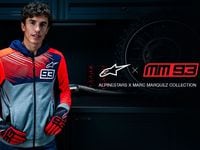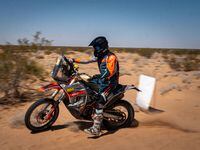I don’t have a motorcycling background, but when I first ran into an electric motorbike —it was a Swiss brand, Quantya—it spoke to me right away. I was curious about the idea of being out there exploring with respect to wildlife, not disturbing, not polluting. I was like, “Wow, this is me!”
I'm a skier, a surfer, a mountain biker. I love speed. I love the challenge of active sports. After riding a lot of electric bikes, I was absolutely convinced that change is coming. We're in a transition period. There will always be a market for motorbikes, but my gut feeling tells me there is a new category being explored here.
The barrier of learning how to ride a motorbike—clutching, changing gears, and so forth—limits the ability for more to ride. Then again, we have issues off-road; you cannot ride everywhere. On my journey getting to where we're at right now, I had to learn to ride a motorbike, so I spent hours on Husqvarna enduros to grasp the space we're in.
The electric drivetrain suits a light, snappy vehicle. The lion's share of our business is going to be off-road inspired, but every model that we introduce will become a commuter bike as well. The average commuting distance is about 8 miles, so this is a perfect vessel for the future when cities around the world need to reorganize.
We realize that we are contributing to moving something forward, and in the end, we'll see if we are the ones actually being perceived as a leader of the category. To me, it's about inviting new people—outdoor people, mountain bikers, motorbike guys, whoever wants to get out there—to experience something new.
Twenty-year-old girls who had never been on a motorbike put on helmets, goggles, boots, and idled away really slowly like, "Oh, this is scary!" They came back after 20 minutes at high speeds, sliding in front of me, saying, "Stefan! This is the most amazing thing I've done in my life!" Then I realized, this is different.
With my previous business, POC helmets, the mission was to save lives and reduce the consequences of accidents by making more accurate crash detection. I didn't know what to name the company but I knew I wanted to use a symbol similar to the crash-test dummy. From above, it looked like two pieces of cake. Now the piece is gone and the cake is left.
We would never brag, saying, "We're electric. Look at us!" A sober perspective is there isn't much difference right now between electric and internal combustion because there are so many challenges. Most of the battery cells, for example, are produced today at coal-burning plants. At this point, there are no real benefits.
Together with a changing market supporting ideas for sustainability, the industry will move at a decent speed. So 10 years from now all of those issues will hopefully be resolved. In that sense, I think we will have a much better alternative compared to current combustion engines. Of course, there will be evolution on that side too.
We have a small group called the Cakeworks, which comprises specialists from different fields, such as sustainability and transportation. We're working in line with UN climate goals, and we've pinpointed seven of those that we can actually support by collaborating with others. It's like looking at ourselves as ants: We need to move collectively toward this goal.
We've developed our own solar panel. With only four panels, you can actually charge the bike without sapping the grid ever again. It's evidence of the kind of technology we've come to at this point, even though we still have a long way to go. Understanding the performance of the bike and realizing you can run it solely by solar power is an amazing thing.
We deliberately chose to launch the bike at the Outdoor Retailer Show in Denver. Fellow exhibitors were Patagonia and The North Face. We sold 50 limited-edition bikes in two weeks—40 percent went to North America, the other 60 percent went to Europe. We'll start delivering the production series after the first of January. Our intention next year is to sell 500 bikes.
We're focusing right now and in the coming five years on Europe and North America. We opened a small office in Los Angeles for sales and marketing purposes. We have a similar office in Central Europe, and there is going to be another one in Scandinavia. Our intention is to not go to China or anywhere else in Asia until we succeed in our home markets.
The bikes are produced in Taiwan. They have such wonderful experience making high-end bicycles. The drivetrain is produced in Europe. We developed the motor with a company in England, and the batteries and controllers are made in the Czech Republic. By late next year, we will be assembling everything in Taiwan and selling direct.
Öhlins has been very supportive. They developed a category-specific fork, and the rear damper is a TTX 22 developed for downhill mountain bikes but it has a heavier spring. It has been an amazing experience but also frustrating for them because there are so many new things. It's been a super rewarding 2-1/2 years.
When I first got to Öhlins, the guys told me, "You need to make a 25mm axle." The satisfaction in this journey comes from realizing there was nothing we could use off the shelf. We're using just three standard products: handgrips, brake levers, and footpegs. Everything else has been engineered, forged, machined, or whatever we had to do in terms of manufacturing.
When I realized we had to make our own axle, I also realized we had to make our own hub. And then we started to question ourselves. What's a wheel, then? We started optimizing the ideas of what we believe could contribute in terms of supporting the category. We ended up making our own tires, for example, with a specific pattern to reduce rolling resistance.
I love what I am doing, same thing with POC. The first two or three years, when you get to 35 people, it's wonderful. The shared perspectives, the kind of gut feeling between everyone on the team knowing exactly what to do, is amazing. Then you get beyond that, suddenly you are 65 or 70 people, and you lose that tempo. I'm in the sweet spot of a startup.
To pursue everything we have planned, we will need to finance the business by about $25 million until 2022. So far, we've raised $7 million. I brought my sons with me; they are now 25 and 23 years old. It was a golden opportunity for me to have them come along and get that startup experience.
One of my sons is really into marketing and social media. The other is really good at electronic engineering. I'm probably a bit harsher toward them than I would be with others, but it's been a great experience. I've spent a lot of time with my kids—skiing, surfing, doing all kinds of sports—and that has really connected us in a strong way.
We have a pretty solid 10-year plan about how we are going to get to 70,000 bikes sold annually. Is that going to happen? I don’t know, but it’s a plan. We’re going to stick to quality—no shortcuts, no cheating—stand behind our products, and serve our customers with the best technology. We are going to be a tiny chunk of the two-wheel market.










/cloudfront-us-east-1.images.arcpublishing.com/octane/HERF2STCHRC4KYOCMAEINNKIKE.jpg)
/cloudfront-us-east-1.images.arcpublishing.com/octane/NYWEK5AP4BILG3PK6BQ2LAACZ4.jpg)
/cloudfront-us-east-1.images.arcpublishing.com/octane/6OQ6E5JBF6G6W6DGI3A65CRZEY.jpg)
/cloudfront-us-east-1.images.arcpublishing.com/octane/XNTDU6LXZ6RJDU2P62GBMY3T2Q.jpg)
/cloudfront-us-east-1.images.arcpublishing.com/octane/MPHXIIV54NAU5L6E4SYZHCXVRM.jpg)



/cloudfront-us-east-1.images.arcpublishing.com/octane/WYXFHF4ZOBBTXELIZDB2FJXU64.jpg)
/cloudfront-us-east-1.images.arcpublishing.com/octane/K5FNV7ONUVDXJJ2H5BIWUGBGTI.jpg)
/cloudfront-us-east-1.images.arcpublishing.com/octane/MGVKP5VTNJHQ7FWNAHIWX4OHO4.jpg)
/cloudfront-us-east-1.images.arcpublishing.com/octane/6JEYTSIZQRHPJAVVPRLWZU63UM.jpg)
/cloudfront-us-east-1.images.arcpublishing.com/octane/XJU3VJZSDFEOVDBJTRXTTLTN5U.jpg)

/cloudfront-us-east-1.images.arcpublishing.com/octane/A6O3TEZF45BVFG2KKOUMPWEYM4.jpg)
/cloudfront-us-east-1.images.arcpublishing.com/octane/MHVFMH2YN5DT3EOZPLXKNFP3VM.jpg)
/cloudfront-us-east-1.images.arcpublishing.com/octane/VILA5L7CTBGOJGDKM2YAOCR6VU.jpg)
/cloudfront-us-east-1.images.arcpublishing.com/octane/GZMZRTYRS5A75G2EJDDGXLJEEE.jpg)
/cloudfront-us-east-1.images.arcpublishing.com/octane/6KWAL3TFNJBGTJMJSKQ2C6I3IY.jpg)
/cloudfront-us-east-1.images.arcpublishing.com/octane/GK5I5R3X7JCABGCKAKT4XY2K7U.jpg)


/cloudfront-us-east-1.images.arcpublishing.com/octane/RGUT3Y65IFGDFMLHQ3U7G5UUQE.jpg)

/cloudfront-us-east-1.images.arcpublishing.com/octane/37CSHD6CKRHYXHRB67EOLDS6XM.jpg)
/cloudfront-us-east-1.images.arcpublishing.com/octane/FYB7GKDGLVE3JKXMM75JTG2RYA.jpg)
/cloudfront-us-east-1.images.arcpublishing.com/octane/3ECVMM622VAZHIOLI6Q6ILWULU.jpg)
